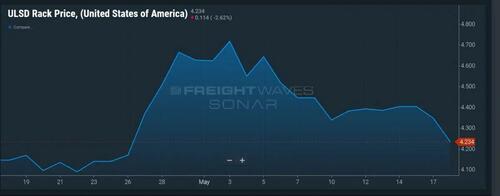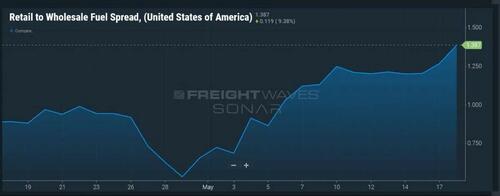Submitted by Hardscrabble Farmer
“Historically, the spread moved up and down over zero enough that it’s accurate to say there’s little difference between the two. The recent spread is an anomaly…”
Um, ‘kay.
Diesel Price Drop, Rising Inventories Suggest East Coast Relief Possible
By John Kingston
Diesel consumers on the East Coast received some news Wednesday that may suggest an easing of the tight physical market squeeze in the region.
There have been head fakes suggesting a softening of markets in the weeks since the East Coast diesel market ran away from the rest of the country. But they proved short-lived, as the weekly national average retail diesel price published Monday by the Energy Information Administration was $5.613 a gallon. The East Coast price was 33.1 cents more than that after a three-week increase that took the spread from 4.9 cents on April 25 up to 19.2 cents the following week and 28.4 cents a week later before the latest jump.
Historically, the spread moved up and down over zero enough that it’s accurate to say there’s little difference between the two. The recent spread is an anomaly, albeit one that is costing drivers on the East Coast a lot of money.
But among the data in the latest weekly report of the EIA released Wednesday, there were several numbers that suggest there is reason to think the squeeze might have become less severe.
The key driver in the squeeze has been inventory levels on the East Coast. But the latest report shows inventories turning up.
Inventories of ultra low sulfur diesel in what the EIA calls PADD 1 — the East Coast — rose 1.21 million barrels last week to 20.4 million barrels. PADD 1 inventories of ULSD on the East Coast had declined in 13 of the 15 previous weeks and had dropped six weeks in a row before the increase the EIA posted Wednesday.
Inventories remain well below historic norms. If the bloated figures from 2020 are not counted, the average size of PADD 1 ULSD inventories in the second weekly report of May over the past five years is 36.8 million barrels. That means that even after the latest increase, East Coast ULSD inventories were just 55.4% of that five-year average.
Prices in spot and futures markets also may be providing a glimmer of hope for consumers. ULSD settled Monday at $3.6681 a gallon, down 13.12 cents on the day. It’s the lowest settlement since April 12, and since the start of May, ULSD is down more than 53 cents, including a decline of more than 25 cents in just the past three trading days.
The decline also was notable because it outpaced the performance of crude and RBOB, an unfinished gasoline blendstock that is used as a proxy for gasoline trade. That trend has been in place for most of May. On the first trading day of the month, the value of a barrel of ULSD was about $69 more than the value of a barrel of Brent crude. That spread is down to about $47.65.
The weekly data report had other figures that could signal the worst on the East Coast might be over, even if it has a long way to climb back toward some semblance of normalcy.
- U.S. refineries ran at 91.8% of capacity. It’s the highest level since August 2021. The nameplate figure for capacity used by the EIA has been reduced over the years, but it’s only down about 1% since last August. On the East Coast, refineries ran at a rate of 95%. East Coast refineries have not run at 95% or above since May 2018, and instances of it in general are rare. But it’s a very different world on the East Coast: Operable capacity back in 2018 was 1.224 million barrels a day. It is now listed as 818,000.
- Stocks of all distillates, which includes diesel but does not include jet fuel, rose to 105.3 million barrels, up from 104 million barrels nationwide a week earlier. Inventories of ULSD nationwide rose to 95.2 million barrels from 94.6 million, though with PADD 1 up more than 1 million barrels, math on the overall national increase means the country outside of PADD 1 declined.
- The total distillate in inventories rose even as the country was consuming more product. Products supplied in distillates — which is mostly diesel but includes some other products, such as heating oil — increased to 3.816 million barrels a day from 3.777 million a week earlier. It’s still down 243,000 barrels per day from a year ago, approximately 5.9%, though jet fuel, which pulls from the same pool of distillate feedstocks as diesel, has seen its consumption increase 439,000 barrels a day, a 37% jump. The total amount of distillate molecules being demanded across various applications is rising, and the rising inventory balances this week suggest those needs were met without a significant pull on stocks.
- Exports of distillates fell. Exports in the EIA weekly report are not broken out by specific product, such as ULSD. But exports of diesel have been cited as a cause of the East Coast squeeze. Total non-jet distillate exports fell to just over 1 million barrels per day last week. It’s the lowest export figure in the last eight weekly reports, where exports a month ago got up to 1.74 million barrels a day. Partly offsetting that, however, is that imports of ULSD — specific import figures are available by category of product, unlike exports — were at the fourth-lowest weekly level they’ve seen all year.
“Distillate exports were strong up until this week and refinery runs are up,” Stephen Jones of Argus Media said. Despite speculation about demand destruction, Jones noted that demand figures in the EIA report were up about 1% from the prior week.
Jones said that in addition to higher refinery runs in the U.S., European refinery runs are running about 1.5 million to 2 million barrels a day more than they were in March and April. The runs are being raised as the region deals with the impact of lost Russian oil because of sanctions, including the reduction in diesel exports from Russia. “They’re going to make more diesel and gasoline, and the sanctions may fall short and not have as big an impact on the loss of supply,” Jones said. “We could end up with significantly excess gasoline for the European market, and a well-supplied [European] distillate market.”
In physical markets, the premium of East Coast diesel relative to Gulf Coast diesel narrowed for the second day in a row. According to benchmark administrator General Index, its assessment for ULSD in New York Harbor was roughly 22.25 cents more than the price in the Gulf Coast. A day earlier, it was 35.75 cents, which on the surface would suggest East Coast supplies easing relative to the Gulf Coast.
However, that market last week did narrow for a few days before blowing back out. It opened the week at approximately a 66-cent spread in favor of the East Coast, per the General Index assessments, came in as tight as 33.5 cents and then blew back out to 76 cents Monday. The reversal has cut the spread by roughly 53 cents.
The various signs pointing downward in the diesel market have not yet made it to the pump. The DTS.USA data series in FreightWaves SONAR shows the national retail average rising to $5.621 a gallon Wednesday, up from $5.577 a week ago.
But wholesale prices do react quickly to movements in the spot market for diesel. The national average wholesale diesel price reflected in the ULSDR.USA data series in SONAR was $4.234 per gallon Wednesday. It was $4.404 a gallon just two days earlier and was as high as $4.718 a gallon on May 3.
Retailers have been slow to move prices down, possibly because they have been so whipsawed by rapidly rising and falling prices that they are reluctant to follow all downward movements in wholesale prices.
The end results, though, are strong retail margins, as evidenced in SONAR’s FUELS.USA data series, which at $1.387 a gallon Wednesday is significantly higher than normal rates near $1 to $1.05 a gallon. FUELS.USA represents a straight difference between wholesale and ret
It is my sincere desire to provide readers of this site with the best unbiased information available, and a forum where it can be discussed openly, as our Founders intended. But it is not easy nor inexpensive to do so, especially when those who wish to prevent us from making the truth known, attack us without mercy on all fronts on a daily basis. So each time you visit the site, I would ask that you consider the value that you receive and have received from The Burning Platform and the community of which you are a vital part. I can't do it all alone, and I need your help and support to keep it alive. Please consider contributing an amount commensurate to the value that you receive from this site and community, or even by becoming a sustaining supporter through periodic contributions. [Burning Platform LLC - PO Box 1520 Kulpsville, PA 19443] or Paypal
-----------------------------------------------------
To donate via Stripe, click here.
-----------------------------------------------------
Use promo code ILMF2, and save up to 66% on all MyPillow purchases. (The Burning Platform benefits when you use this promo code.)








Thank You for Your continuing efforts.
Seem to recall something You said concerning pigs and what i assume is biodiesel from the fat?
Would be interesting/ educational to hear about those exploits, Your time/inclination permitting. Little i’ve read sounds highly technical and complicated, fairly substantial ‘Up-Front’ investment.
Certain that You could explain the highlights/recommend ‘Good’ reference material to the layman.
As if You don’t contribute enough already. For ‘Free’.
Again, Thank You sincerely for Your efforts over time.
https://d1io3yog0oux5.cloudfront.net/capstoneturbine/db/Case+Studies/672/pdf/CS_CAP427_Swineline_lowres.pdf
Methane gas production from hog waste in South Africa. Mother Earth News wrote of this back in 1970s. There was a time back trucks were using propane, so they can run on methane.
It is like saying that breathing in an out moves so little air that, for all intents and purposes, it is statistically irrelevant so you might as well stop breathing since it makes no difference to your wellbeing.
I know a few people who should be volunteered for a research study where we put that theory to the test. 10 minutes should suffice to get a result, I think.
DEF fluid is the linchpin or the wheel comes off.
When a truckie rolls by wif the groceries or drugs look for the DEF tank near the fuel tanks. No DEF no run.
Remember when the firetrucks and Whammbulances used to stop to regenerate? This is even better.
My diesels are mechanical.
Totally correct DEF fluid is a boondoggle
Amen. And, I doubt various brands of it consistently meet the AdBlue® standard.
I got fascinated with policy wonkism when I returned to college post USAF career, ended early with a back strain that rendered me medically unfit for flying status .
I did cartwheels out the door with a GI Bill package from the VA that paid me to go to college for the first eight years of my son’s life and be his homeroom mother and a fly on the wall in several branches of academia from preschool lessons at the church through private and public school parent-teacher meetings to the decision-makers in David Boren’s empire at the University of Oklahoma, where I literally revised and edited the Syllabus and Curriculum for the Masters in Public Policy Degree Program for a team of political science professors, two of which who’d become my mentors and friends as I spent the 1990s taking as many classes as I could take without actually having to go to a lot of classes.
(That is a 134-word sentence which says I am proficient in policy wonk.)
Now, let me tell you what I see written between the lines.

https://www.sciencedirect.com/science/article/abs/pii/S0960852411013563
Fatty acid content of animal fats
[[ Animal fats remain fairly saturated, which means that the fat solidifies at a subjectively high temperature. Consequently, biodiesel made from animal fat has a high cloud point (The cloud point is the lowest temperature at which the paraffins or waxes in an oil reach a certain level of turbidity). For example, biodiesel made from beef tallow and lard has a cloud point in the range of 55 ° F to 60 ° F. B100 (pure biodiesel) made from animal fat should only be used in fairly hot climates. However, biodiesel from animal fat can be mixed with diesel oil. In lower blends like B5 (a blend of 5% biodiesel with 95% petro-diesel), the high cloud point of animal fat biodiesel does not have much of an impact on the cloud point of the blend.
Beef tallow and lard typically remain 40% saturated (sum of myristic, palmitic, and stearic acids). Chicken fat is less by around 30-33%. For comparison, soybean oil is 14% saturated and canola oil is only 6% saturated. Consequently, tallow and lard tend to be stiff at room temperature and chicken fat, while still mainly liquid, is quite viscous and almost solid.]]
In a world where those in power are obviously destroying all of the institutions which protected individual rights while creating a false demand for collectivist thought, it certainly explains why there is a pandemic of obesity celebrated as healthy and beautiful. While at the same time, global warming and climate change are mentioned relentlessly in wonkish circles.
With a new global treaty on pandemic control being ratified by the WHO this weekend.
Perhaps the new biodiesel will be called Soylent Fuel.
Thank You. Lots to digest, lol.
Read some story in high school…Egads! 42-44 yrs ago, May have even been 10th or 9th grade…about a skinny guy and a fat guy stranded, i believe in the desert. found and old car. skinny guy used the fat guy for lubricant and fuel as i recall.
I read the entire Dune novels during that same time in college at OU. If you’ve never read the series, only watched the movie, you probably don’t realize that the idea of humans being rendered into reusable products to retrieve their water for the tribe of Freemen was alluded to many times. Water was precious on Dune because the hot desert atmosphere was the ideal environment for the big sandworms whose explosive death resulted in a big Spice blow as well as the release of a whole lot of little sand tadpoles.
Spice is what fuels the economy as well as an addictive drug to humans and what the author’s main point seemed to be was that in spite of Dune being an almost irrelevant planet in a thriving planetary system, the importance of its one export, Spice, made it the pivotal point for all the schemes of all the great players in that universe. I know several folks here at TBP call them the luciferian powers that be.
In a world gone Green (with envy), I seen increased possibilities for man’s inhumanity to man.
They are already trying to teach our children to be sexual eunuchs, unable to actually enjoy sex but trained that they like it better in the behind. Why not encourage them to become as fat as possible before their little over-vaccinated hearts burst.
Once society accepts the view of children as sexual playthings as simply a sexual fetish or fantasy instead of the abhorrent deviancy it is, while introducing the idea of gender transformation to children unable to comprehend the long-term impact of such procedures, in order to groom them in the way in which they are trained to go, there really is no hope for the society.
Public policy has nothing to do with public good.
Thanks for the Dune© reference. Maybe this winter.
This guy is confused. In one paragraph he says jet fuel (“JP”) is not a distillate but in another it is. After 46 years in the biz, JP is most certainly a middle distillate, as are various mineral spirits (aka Varsol®).
#2 heating oil is just ULSD with more sulfur, which adds BTUs/gal. JP is simply very filtered kerosene.
Thanks for the tech specs.
If East Coast diesel supply is up and the price is softening why has it gone up 10cents again this week? When all this shit started 6 months ago I ranted to admin that a local station had 6.49 on their diesel sign when everyone else was in the high 4’s low 5’s. Now it’s 6.49 everywhere!
Back in the early 2000’s I was making bio-D with waste oil from the local restaurant and heating my workshop with it. I still believe bio-D is an actual plausible biofuel vs ethanol but FedGov has no interest in it. Several plants sprung up and were served by rail close to me. All are now shuttered.
I’m certainly not running homebrew and risking a $12K engine replacement.
Thermal polymerization was a hot concept for a while. Feedstock was junk plastic and the output was crude oil. FedGov also had no interest. Same with algae oil.
Regarding DEF, there are plenty of non-commercial vehicles that hit a pothole and some metal junk falls off. Strangely, they don’t need DEF anymore to operate after that.
Same as ‘Fuel cells’ Must have been a good thing for ‘Us’, Not much of a Gold Mine for them. Seem to remember reading it’s what stopped Tesla’s wireless transmission of electricity, no way to bill for it.